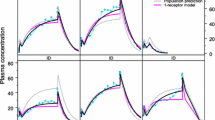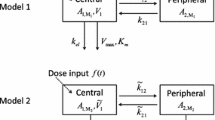Abstract
General equations for the time integral on [0, ∞) of the venous drug concentrationtime function after intravenous and oral drug administration are derived. A physiologically realistic stochastic recirculating model is applied in the derivations. The quotient of the intravenous drug dose and the integral on [0, ∞) of the resulting venous blood drug concentration function is equivalent to a summation of organ clearances only provided that drug elimination does not occur in the pulmonary system, and in general it is not equivalent to “total body clearance.” In general, mammillary compartmental models are not isomorphic with recirculating models. A necessary condition for isomorphism is that the pulmonary system be conservative toward the drug. Equations for the pulmonary “first-pass” effect derived via the compartmental analysis are invalid. A valid expression for the pulmonary “first-pass” effect is derived. General equations derived via compartmental analysis for the extent of hepatic metabolism and the hepatic “first-pass” effect are shown to be valid. A generally applicable expression for the advantage of close intraarterial drug administration is derived. The limitations of compartmental models for representing drug distribution and elimination are discussed, and the advantages of recirculating models are emphasized.
Similar content being viewed by others
References
J. B. Bassingthwaighte. Blood flow and diffusion through mammalian organs.Science 167:1347–1353 (1970).
J. G. Wagner. Do you need a pharmacokinetic model and if so which one.J. Pharmacokin. Biopharm. 3:457–478 (1975).
D. P. Vaughan and M. Dennis. Number of exponential terms describing the solution of anN-compartmental mammillary model-vanishing exponentials.J. Pharmacokin. Biopharm. (in press).
L. Z. Benet and C.-W. N. Chiang. The use of deconvolution methods in pharmacokinetics. In abstracts of papers presented to the 13th National Meeting of the AphA Academy of Pharmaceutical Sciences, Chicago, November, Vol. 2, No. 2, 1972, pp. 169–171.
A. Resigno and G. Segre.Drug and Tracer Kinetics, Blaisdell, Waltham, Mass., 1966, p. 102.
D. P. Vaughan and M. Dennis. Mathematical basis of the “point-area” deconvolution method for determiningin vivo input functions.J. Pharm. Sci. 67:663–667 (1978).
D. P. Vaughan and G. T. Tucker. General derivation of the ideal drug input required to achieve and maintain a constant plasma drug concentration: Theoretical application to lignocaine therapy.Eur. J. Clin. Pharmacol. 10:433–440 (1976).
D. P. Vaughan and A. Trainor. A general equation for the ratio of the areas below the blood or plasma concentration-time curves following intravenous and oral drug administration and its applications to inter-subject variations in drug elimination.Br. J. Clin. Pharmacol. 2:239–250 (1975).
M. Gibaldi, R. N. Boyes, and S. Feldman. Influence of first-pass effect on availability of drugs on oral administration.J. Pharm. Sci. 60:1338–1340 (1971).
D. P. Vaughan. Estimation of biological availability after oral drug administration when the drug is eliminated by urinary excretion and metabolism.J. Pharm. Pharmacol. 27:458–461 (1975).
D. P. Vaughan. Model independent derivation of general equations for first-pass effect and extra hepatic drug elimination.Eur. J. Clin. Pharmacol. 11:57–64 (1977).
W. L. Chiou. Quantitation of hepatic and pulmonary first-pass effect and its applications in pharmacokinetic study.J. Pharmacokin. Biopharm. 3:193–201 (1975).
M. Rowland, L. Z. Benet, and G. G. Graham. Clearance concepts in pharmacokinetics.J. Pharmacokin. Biopharm. 1:123–135 (1973).
C. A. Keele and E. Neil.Samson Wright's Applied Physiology, 10th ed., Oxford University Press, London, 1961, p. 136.
K. B. Bischoff, R. L. Dedrick, D. S. Zaharko, and J. A. Longstreth. Methotrexate pharmacokinetics.J. Pharm. Sci. 60:1128–1133 (1971).
K. B. Bischoff and R. L. Dedrick. Thiopental pharmacokinetics.J. Pharm. Sci. 57:1346–1357 (1968).
N. Benowitz, R. F. Forsyth, K. L. Melinon, and M. Rowland. Lidocaine disposition kinetics in monkey and man. II. Effect of haemorrage and sympathomimetic drug administration.Clin. Pharmacol. Ther. 16:99–109 (1974).
R. L. Dedrick. Animal scale-up.J. Pharmacokin. Biopharm. 1:435–461 (1973).
B. M. Brown.The Mathematical Theory of Linear Systems, Chapman and Hall, London, 1961.
D. S. Riggs.Control Theory and Physiological Feedback Mechanisms, Williams and Wilkins, Baltimore, 1970.
G. Doetsch.Guide to the Application of Laplace Transforms, Van Nostrand, London, 1961.
A. M. Krall.Stability Techniques for Continuous Linear Systems, Thomas Nelson, London, 1968.
D. P. Vaughan. A model-independent proof of Dost's law of corresponding areas.J. Pharmacokin. Biopharm. 5:271–276 (1977).
J. L. Stephenson. Theory of transport in linear biological systems. I. Fundamental integral equation.Bull. Math. Biophys. 22:131–138 (1960).
K. L. Zierler. A critical comprehensive presentation of physiological knowledge and concepts. In W. F. Hamilton and P. Dow (eds.),Handbook of Physiology, Section 2:Circulation, Vol. 1, American Physiological Society, Washington D.C., 1962, pp. 585–615.
H. E. Hart. Analysis of tracer experiments. VIII. Integrodifferential equation treatment of partly accessible partly injectable multicompartment systems.Bull. Math. Biophys. 29:319–333 (1967).
C. Waterhouse and J. Keilson. Transfer times across the human body.Bull. Math. Biophys. 34:33–44 (1972).
E. Moller, J. F. McIntosh, and D. D. Van Slyke. Studies of urea excretion. II. Relationship between urine volume and the rate of urea excretion by normal adults.J. Clin. Invest. 6:427–434 (1929).
N. Jolliffe and H. W. Smith. The excretion of urine in the dog. I. The urea and creatinine clearances on a mixed diet.Am. J. Physiol. 98:572–585 (1931).
D. Schachter, N. Freinkel, and I. L. Schwartz. Movement of inulin between plasma and interstitial fluid.Am. J. Physiol. 160:532–539 (1950).
J. S. Robson, M. H. Ferguson, O. Olbrich, and C. P. Stewart. The determination of renal clearance of inulin in man.Q. J. Exp. Physiol. 35:111–117 (1949).
C. Brun, T. Hilden, and F. Raaschou. The significance of the difference in systemic arterial and venous plasma concentrations in renal clearance methods.J. Clin. Invest. 28:144–151 (1949).
E. Bojesen. The function of the urinary tract as “dead space” in clearance experiments.Scand. J. Clin. Lab. Invest. 1:290–294 (1949).
H. W. Smith.The Kidney Structure and Function in Health and Disease, Oxford University Press, New York, 1951, pp 62–75.
M. Rowland. Influence of route of administration on drug availability.J. Pharm. Sci. 61:70–74 (1972).
W. W. Eckman, C. S. Patlak, and J. D. Fenstermacher. A critical evaluation of the principles governing the advantages of intraarterial infusions.J. Pharmacokin. Biopharm. 2:257–285 (1974).
D. J. Cutler. Scientific commentary: Linear systems analysis in pharmacokinetics.J. Pharmacokin. Biopharm. 6:265–282 (1978).
Author information
Authors and Affiliations
Rights and permissions
About this article
Cite this article
Vaughan, D.P., Hope, I. Applications of a recirculatory stochastic pharmacokinetic model: Limitations of compartmental models. Journal of Pharmacokinetics and Biopharmaceutics 7, 207–225 (1979). https://doi.org/10.1007/BF01059739
Received:
Revised:
Published:
Issue Date:
DOI: https://doi.org/10.1007/BF01059739




